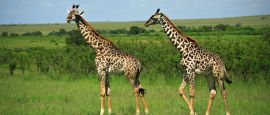Kenya Weather, climate and geography
Weather & climate
Kenya has three types of climate: temperate subtropical climate in the west and southwest highlands (where Nairobi is located), hot and humid along the coast, and hot and dry in the north and east.
Nairobi is the capital and the largest city in Kenya and experiences a subtropical highland climate. Sitting at 1,795 metres (5,889 ft) above sea level, Nairobi's evenings are cooler. The best time to visit Nairobi is from June to August when the average high is around 23°C (73°F) and rainfall is at its lowest (although the sky is often cloudy). The period between January to February is also a good time to visit Nairobi as it is sunny and warm, with an average high of 27°C (81°F). The short rainy season from late October to December and from March to May should be avoided.
Mombasa is a coastal city and the second-largest city after Nairobi, situated along the Indian Ocean. This city has a tropical wet and dry climate. Avoid April and May as these are the wettest months and the area can be affected by flooding. The best time to visit Mombasa is either July to September as sunshine is abundant, as well as from October to March for aquatic activities.
Malindi, a town on Malindi Bay at the mouth of the Galana River, is also situated alongside the Indian Ocean coast and is 120km (75 miles) northeast of Mombasa. Malindi has a tropical dry savannah climate. The cooler season from June to September sees the average high at 27/28°C (81/82°F), while the average high can reach 31°C (88°F) during the hotter season from November to March. With regards to rainfall, it is not particularly abundant, as it only amounts to about 1,000 millimetres (40 inches) per year, however, there are two rainy seasons: from April to June and October to November.
Masai Mara is an expansive game reserve renowned for its wealth of wildlife and the Great Migration of wildebeest to and from the Serengeti every year. This area is located just south of the equator at an altitude of between 1,500 and 1,900 metres (5,000 and 6,200 ft). The climate is pleasantly warm all year round, averaging 23°C (73°F), although it is widely classified into two seasons - dry and wet. The dry season (late June to October) is best for safari as wildlife is easier to spot given that the bush is less dense and animals gather around waterholes and rivers. During this period, the days are clear with sunny skies, with fewer mosquitos, and the average high is around 25°C (77°F). The wet season is from November to May with April being the wettest month, does result in beautiful scenery, cheaper rates and newborn animal sightings.
For Nairobi and the coast: lightweight cottons and linens are advised. Warmer clothing is needed in June and July, while rainwear is advisable between March and June, and October and December.
For safari: loose-fitting and light neutral tones are recommended. If you are visiting a luxury lodge, pack a nice set of clothes for dinner is recommended.
Geography
Kenya covers 580,367 sq km (224,081 sq miles) and sits astride the equator. It shares borders with Ethiopia in the north, Sudan in the northwest, Uganda in the west, Tanzania in the south and Somalia in the northeast. To the east lies the 480 km (300 miles) Indian Ocean coastline. The country is divided into four regions: the arid deserts of the north; the savannah lands of the south; the fertile lowlands along the coast; and highlands in the west, where the capital Nairobi is situated.
Northwest of Nairobi runs the Rift Valley, dotted with lakes and containing the town of Nakuru, while further west the Aberdare National Park is overlooked by Kenya’s highest peak, and Africa’s second tallest mountain after Mount Kilimanjaro, Mount Kenya (5,199m/17,057ft), which also is a national park. In the far northwest is Lake Turkana (formerly Lake Rudolph), and in the southwest is Kenya's share of Lake Victoria.
Do you have any Feedback about this page?
© 2025 Columbus Travel Media Ltd. All rights reserved. No part of this site may be reproduced without our written permission, click here for information on Columbus Content Solutions.




 You know where
You know where